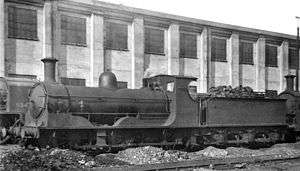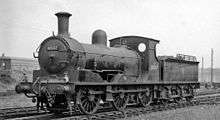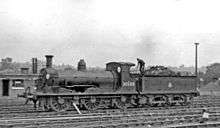LSWR 395 class
The LSWR 395 class was a class of goods 0-6-0 steam locomotives designed for the London and South Western Railway by William Adams as part of his modernisation programme. All 70 were constructed by Neilson and Company between 1881 and 1886. The last 34 locomotives differed in being slightly longer and heavier.[1]
| LSWR 395 class | |||||||||||||||||||||||||||||||||||||
|---|---|---|---|---|---|---|---|---|---|---|---|---|---|---|---|---|---|---|---|---|---|---|---|---|---|---|---|---|---|---|---|---|---|---|---|---|---|
 3167 at Feltham depot 1947 | |||||||||||||||||||||||||||||||||||||
| |||||||||||||||||||||||||||||||||||||
| |||||||||||||||||||||||||||||||||||||
| |||||||||||||||||||||||||||||||||||||
| |||||||||||||||||||||||||||||||||||||
On the LSWR 1881-1923
Early members of the class were numbered in a continuous series of new numbers 395-406. Some later batches re-used numbers of withdrawn or duplicated locomotives. The 395 was a long-lived class, with several lasting for 70 years. Between 1908 and 1924, 54 locomotives were renumbered to the duplicate list by prefixing their existing number with a "0".
| Year | Builder serial number | Quantity | LSWR Numbers | Notes |
|---|---|---|---|---|
| 1881 | Neilson & Co. 2747–2751 | 5 | 395–399 | |
| 1882 | Neilson & Co. 2752–2758 | 7 | 400–406 | |
| 1883 | Neilson & Co. 2939–2950 | 12 | 153–167 | |
| 1883 | Neilson & Co. 2956-2967 | 12 | 433–444 | |
| 1885 | Neilson & Co. 3376–3391 | 16 | 496–511 | |
| 1885 | Neilson & Co. 3453–3462 | 10 | 27–30, 67, 71, 101, 105, 134, 148 | 67 and 71 renumbered 83 and 84 in 1889 |
| 1886 | Neilson & Co. 3392–3395 | 4 | 512–515 | |
| 1886 | Neilson & Co. 3463–3466 | 4 | 168, 172, 174–175 | |
Outside the UK 1916-1945
Between 1916 and 1918 fifty locomotives were sold to the British Government for use by the Railway Operating Division of the Royal Engineers. These included all 16 not in the duplicate list. The ROD transferred 36 of the class to its Palestine Military Railway and nine for service in the Mesopotamian campaign. In 1918 seven of those delivered to Palestine were transferred to Mesopotamia.
In 1919 military-controlled railways and equipment in Mesopotamia were transferred to the civilian Mesopotamian Railways, including all 16 class 395's which the new company renumbered 423-438.[2] In 1920 the civilian Palestine Railways was formed and took over the remaining PMR lines and stock, including all 29 class 395's remaining in Palestine. In 1928 PR withdrew 22 of the class and sold them for scrap. The remaining seven (0166, 0395, 0398, 0405, 0444, 503 and 508) remained in PR service until 1936 and were not scrapped until 1944-45.[3]
In the UK 1923-1959


After the First World War twenty class 395's remained in Great Britain in L&SWR service: 029, 083, 0101, 0153–0155, 0163, 0167, 0397, 0400, 0433, 0436, 0439–0442, 0496, 0506, 0509, 0515. In the grouping in 1923 these passed to the Southern Railway. In 1933 the SR withdrew 0153 and 0515. In 1948 under the nationalisation of Britain's Railways the remaining 18 locomotives entered British Railways stock and were renumbered in a continuous series 30564–30581. Withdrawals resumed in 1953, with the last one, 30567 (né 154) being withdrawn in September 1959 after 76 years of service. All were scrapped.
| Year | Quantity in service at start of year | Quantity withdrawn | Locomotive numbers | Notes |
|---|---|---|---|---|
| 1916 | 70 | 17 | 084, 0104, 0148, 0157, 0159, 0164, 0166, 0172, 0175, 0395, 0399, 0405, 0435, 507, 510, 511, 513 | all sold to the Government |
| 1917 | 53 | 27 | 027, 028, 030, 0156, 0158, 0168, 0174, 0396, 0398, 0401–0403, 0438, 0443, 0444, 497–505, 508, 512, 514 | all sold to the Government |
| 1918 | 26 | 6 | 0105, 0165, 0404, 0406, 0434, 0437 | all sold to the Government |
| 1933 | 20 | 2 | E153A, E515A | |
| 1950 | 18 | 1 | 30576 | ex 440 |
| 1953 | 17 | 3 | 30565, 30571, 30581 | ex 83, 397, 509 |
| 1956 | 14 | 5 | 30569, 30570, 30573, 30577, 30579 | ex 163, 167, 433, 441, 496 |
| 1957 | 9 | 4 | 30572, 30574, 30578, 30580 | ex 400, 436, 442, 506 |
| 1958 | 5 | 3 | 30564, 30568, 30575 | ex 29, 155, 439 |
| 1959 | 2 | 2 | 30566, 30567 | ex 101, 154 |
References
- Russell (1991) p. 147
- Hughes (1981) p. 116
- Cotterell (1984) p. 127
- Cotterell, Paul (1984). The Railways of Palestine and Israel. Tourret Publishing. pp. 28, 127. ISBN 0-905878-04-3.
- Hughes, Hugh (1981). Middle East Railways. Continental Railway Circle. pp. 98, 116. ISBN 0-9503469-7-7.
- Russell, J. H. (1991). Pictorial Record of Southern Locomotives. Haynes (Oxford Publishing). pp. 147–150. ISBN 0-86093-443-8.
| Wikimedia Commons has media related to LSWR 395 class. |